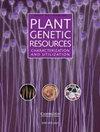利用农业形态和分子标记对产油葫芦(Lagenaria siceraria)种质资源进行遗传分析
IF 0.7
4区 生物学
Q3 PLANT SCIENCES
Plant Genetic Resources: Characterization and Utilization
Pub Date : 2022-11-21
DOI:10.1017/s1479262122000247
引用次数: 0
摘要
利用9个农艺性状和31个扩增片段长度多态性(AFLP)标记对种子再生和维持困难的油瓜进行了研究。具体而言,该研究旨在确定来自Côte科特迪瓦5个农业生态区(中部、东部、北部和南部)的173个物种的种内变异。利用AFLP标记分析了种质间的遗传多样性和亲缘关系。利用形态和AFLP标记实现了这种表征,以便最终建立可靠的核心集合。利用9个数量性状进行判别分析,发现单果种子数和株长是判别性状。在用于农形态研究的材料中,有148份能够被AFLP标记区分。每个引物组合扩增出52 ~ 113个条带。分子方差分析(AMOVA)表明,总变异的28%发生在种质间,72%发生在种群内。在不考虑事先分组的情况下,为区分品种而计算的AMOVA也显示出相同的趋势。品种内分化率(97%)高于品种间分化率(3%)。通过邻居连接分析推断的树拓扑没有明确的切断分组。为了对条目进行分组,我们使用了贝叶斯聚类分析,它显示了两个聚类。利用本研究分析的引物组合的信息量,给出了选择将用于构建核心馆藏的引物组合的方向。本文章由计算机程序翻译,如有差异,请以英文原文为准。
Genetic characterization of oleaginous bottle gourd (Lagenaria siceraria) germplasm from Côte d'Ivoire using agromorphological and molecular markers
Being difficult to regenerate and maintain the seeds, the oleaginous bottle gourd was investigated using nine agromorphological traits and 31 amplified fragment length polymorphism (AFLP) markers. Specifically, the study was conducted to determine the intra-specific variability of a total of 173 accessions, which were identified from five agro-ecological regions from Côte d'Ivoire (Centre, East, North and South). Then, the genetic diversity and relationships within accessions were studied using AFLP markers. This characterization using both morphological and AFLP markers was realized in order to ultimately build a reliable core collection. The discriminant analysis, using nine quantitative traits, reveals plant length and seeds number per fruit as discriminating characteristics. From the accessions used for the agromorphological study, 148 were able to be differentiated by the AFLP markers. A range of 52 to 113 bands were amplified per primer combination. As revealed by the analysis of molecular variance (AMOVA), 28% of the total variation resides among accessions and 72% occurs within populations. The AMOVA computed in order to differentiate cultivars, displayed the same trends when no prior grouping of accessions was considered. The differentiation within cultivar (97%) was more than that, among cultivars (3%). Tree topologies inferred by neighbour-joining analysis reflected no clear cut off grouping.
To group accessions, we used a Bayesian clustering analysis which exhibited two clusters. Using the informativeness of the primer combinations analysed in the present study, an orientation was given for the choice of the accessions which would be used to build a core collection.
求助全文
通过发布文献求助,成功后即可免费获取论文全文。
去求助
来源期刊

Plant Genetic Resources: Characterization and Utilization
Agricultural and Biological Sciences-Agronomy and Crop Science
CiteScore
2.80
自引率
0.00%
发文量
29
审稿时长
>12 weeks
期刊介绍:
Plant Genetic Resources is an international journal which provides a forum for describing the application of novel genomic technologies, as well as their integration with established techniques, towards the understanding of the genetic variation captured in both in situ and ex situ collections of crop and non-crop plants; and for the airing of wider issues relevant to plant germplasm conservation and utilisation. We particularly welcome multi-disciplinary approaches that incorporate both a technical and a socio-economic focus. Technical aspects can cover developments in technologies of potential or demonstrated relevance to the analysis of variation and diversity at the phenotypic and genotypic levels.
 求助内容:
求助内容: 应助结果提醒方式:
应助结果提醒方式:


